Electro-Magnetic Geophysical Dynamics under Conservation and Conventional Farming
Abstract
1. Introduction
2. Materials and Methods
2.1. Site Description
2.2. Data Collection
2.3. Electrical Resistivity Tomography
2.4. Frequency-Domain Electromagnetic Method
2.5. Statistical Analysis
3. Results
3.1. Weather and Soil Monitoring
3.2. Electrical Resistivity Tomography
3.3. Frequency-Domain Electromagnetic Method
3.4. Comparison between EC and Soil Properties
4. Discussion
5. Conclusions
Author Contributions
Funding
Data Availability Statement
Acknowledgments
Conflicts of Interest
References
- Bronick, C.J.; Lal, R. Soil Structure and Management: A Review. Geoderma 2005, 124, 3–22. [Google Scholar] [CrossRef]
- Hamza, M.A.; Anderson, W.K. Soil Compaction in Cropping Systems: A Review of the Nature, Causes and Possible Solutions. Soil Tillage Res. 2005, 82, 121–145. [Google Scholar] [CrossRef]
- Wösten, J.H.M.; Pachepsky, Y.A.; Rawls, W.J. Pedotransfer Functions: Bridging the Gap between Available Basic Soil Data and Missing Soil Hydraulic Characteristics. J. Hydrol. 2001, 251, 123–150. [Google Scholar] [CrossRef]
- Henderson-Sellers, A. Soil Moisture: A Critical Focus for Global Change Studies. Glob. Planet. Chang. 1996, 13, 3–9. [Google Scholar] [CrossRef]
- Laloy, E.; Javaux, M.; Vanclooster, M.; Roisin, C.; Bielders, C.L. Electrical Resistivity in a Loamy Soil: Identification of the Appropriate Pedo-Electrical Model. Vadose Zone J. 2011, 10, 1023–1033. [Google Scholar] [CrossRef]
- Romero-Ruiz, A.; Linde, N.; Baron, L.; Breitenstein, D.; Keller, T.; Or, D. Lasting Effects of Soil Compaction on Soil Water Regime Confirmed by Geoelectrical Monitoring. Water Resour. Res. 2022, 58, e2021WR030696. [Google Scholar] [CrossRef]
- Binley, A.; Hubbard, S.S.; Huisman, J.A.; Revil, A.; Robinson, D.A.; Singha, K.; Slater, L.D. The Emergence of Hydrogeophysics for Improved Understanding of Subsurface Processes over Multiple Scales. Water Resour. Res. 2015, 51, 3837–3866. [Google Scholar] [CrossRef] [PubMed]
- Garré, S.; Günther, T.; Diels, J.; Vanderborght, J. Evaluating Experimental Design of ERT for Soil Moisture Monitoring in Contour Hedgerow Intercropping Systems. Vadose Zone J. 2012, 11, vzj2011.0186. [Google Scholar] [CrossRef]
- Garré, S.; Hyndman, D.; Mary, B.; Werban, U. Geophysics Conquering New Territories: The Rise of “Agrogeophysics”. Vadose Zone J. 2021, 20, e20115. [Google Scholar] [CrossRef]
- Samouëlian, A.; Cousin, I.; Tabbagh, A.; Bruand, A.; Richard, G. Electrical Resistivity Survey in Soil Science: A Review. Soil Tillage Res. 2005, 83, 173–193. [Google Scholar] [CrossRef]
- Piccoli, I.; Furlan, L.; Lazzaro, G.; Morari, F. Examining Conservation Agriculture Soil Profiles: Outcomes from Northeastern Italian Silty Soils Combining Indirect Geophysical and Direct Assessment Methods. Eur. J. Soil Sci. 2020, 71, 1064–1075. [Google Scholar] [CrossRef]
- Cassiani, G.; Ursino, N.; Deiana, R.; Vignoli, G.; Boaga, J.; Rossi, M.; Perri, M.T.; Blaschek, M.; Duttmann, R.; Meyer, S.; et al. Noninvasive Monitoring of Soil Static Characteristics and Dynamic States: A Case Study Highlighting Vegetation Effects on Agricultural Land. Vadose Zone J. 2012, 11, vzj2011.0195. [Google Scholar] [CrossRef]
- Ursino, N.; Cassiani, G.; Deiana, R.; Vignoli, G.; Boaga, J. Measuring and Modeling Water-Related Soil–Vegetation Feedbacks in a Fallow Plot. Hydrol. Earth Syst. Sci. 2014, 18, 1105–1118. [Google Scholar] [CrossRef]
- Blanchy, G.; Virlet, N.; Sadeghi-Tehran, P.; Watts, C.W.; Hawkesford, M.J.; Whalley, W.R.; Binley, A. Time-intensive Geoelectrical Monitoring under Winter Wheat. Near Surf. Geophys. 2020, 18, 413–425. [Google Scholar] [CrossRef]
- Besson, A.; Séger, M.; Giot, G.; Cousin, I. Identifying the Characteristic Scales of Soil Structural Recovery after Compaction from Three In-Field Methods of Monitoring. Geoderma 2013, 204–205, 130–139. [Google Scholar] [CrossRef]
- Allred, B.J.; Freeland, R.S.; Farahani, H.J.; Collins, M.E. Agricultural Geophysics: Past, Present, and Future. In Proceedings of the Symposium on the Application of Geophyics to Engineering and Environmental Problems, SAGEEP, Keystone, CO, USA, 11–15 April 2010; J and N Group, Ltd.: West Malling, UK, 2010; Volume 1, pp. 190–202. [Google Scholar]
- Beff, L.; Günther, T.; Vandoorne, B.; Couvreur, V.; Javaux, M. Three-Dimensional Monitoring of Soil Water Content in a Maize Field Using Electrical Resistivity Tomography. Hydrol. Earth Syst. Sci. 2013, 17, 595–609. [Google Scholar] [CrossRef]
- Cassiani, G.; Boaga, J.; Vanella, D.; Perri, M.T.; Consoli, S. Monitoring and Modelling of Soil-Plant Interactions: The Joint Use of ERT, Sap Flow and Eddy Covariance Data to Characterize the Volume of an Orange Tree Root Zone. Hydrol. Earth Syst. Sci. 2015, 19, 2213–2225. [Google Scholar] [CrossRef]
- Best Practices in Electrical Resistivity Imaging: Data Collection and Processing, and Application to Data from Corinna, Maine. Available online: https://clu-in.org/programs/21m2/projects/EPA_admin_report_02Dec2008_final.pdf (accessed on 9 November 2022).
- Binley, A.; Kemna, A. DC Resistivity and Induced Polarization Methods. In Hydrogeophysics; Springer: Dordrecht, The Netherlands, 2005; pp. 129–156. [Google Scholar]
- Binley, A. Tools and Techniques: Electrical Methods; Elsevier B.V.: Amsterdam, The Netherlands, 2015; Volume 11, ISBN 9780444538031. [Google Scholar]
- Corwin, D.L.; Lesch, S.M. Apparent Soil Electrical Conductivity Measurements in Agriculture. Comput. Electron. Agric. 2005, 46, 11–43. [Google Scholar] [CrossRef]
- Yao, R.; Yang, J.; Wu, D.; Xie, W.; Gao, P.; Jin, W. Digital Mapping of Soil Salinity and CropYield across a Coastal Agricultural LandscapeUsing Repeated Electromagnetic Induction(EMI) Surveys. PLoS ONE 2016, 11, 153377. [Google Scholar] [CrossRef]
- Doolittle, J.A.; Brevik, E.C. The Use of Electromagnetic Induction Techniques in Soils Studies. Geoderma 2014, 223–225, 33–45. [Google Scholar] [CrossRef]
- Triantafilis, J.; Lesch, S.M. Mapping Clay Content Variation Using Electromagnetic Induction Techniques. Comput. Electron. Agric. 2005, 46, 203–237. [Google Scholar] [CrossRef]
- Brogi, C.; Huisman, J.A.; Pätzold, S.; von Hebel, C.; Weihermüller, L.; Kaufmann, M.S.; van der Kruk, J.; Vereecken, H. Large-Scale Soil Mapping Using Multi-Configuration EMI and Supervised Image Classification. Geoderma 2019, 335, 133–148. [Google Scholar] [CrossRef]
- Boaga, J. The Use of FDEM in Hydrogeophysics: A Review. J. Appl. Geophys. 2017, 139, 36–46. [Google Scholar] [CrossRef]
- Lesch, S.M.; Rhoades, J.D.; Lund, L.J.; Corwin, D.L. Mapping Soil Salinity Using Calibrated Electromagnetic Measurements. Soil Sci. Soc. Am. J. 1992, 56, 540–548. [Google Scholar] [CrossRef]
- Corwin, D.L.; Lesch, S.M. Application of Soil Electrical Conductivity to Precision Agriculture. Agron. J. 2003, 95, 455. [Google Scholar] [CrossRef]
- Sheets, K.R.; Hendrickx, J.M.H. Noninvasive Soil Water Content Measurement Using Electromagnetic Induction. Water Resour. Res. 1995, 31, 2401–2409. [Google Scholar] [CrossRef]
- Reedy, R.; Scanlon, B.R. Soil Water Content Monitoring Using Electromagnetic Induction. J. Geotech. Geoenviron. Eng. 2003, 129, 1028–1039. [Google Scholar] [CrossRef]
- Boaga, J.; Ghinassi, M.; D’Alpaos, A.; Deidda, G.P.; Rodriguez, G.; Cassiani, G. Geophysical Investigations Unravel the Vestiges of Ancient Meandering Channels and Their Dynamics in Tidal Landscapes. Sci. Rep. 2018, 8, 1708. [Google Scholar] [CrossRef]
- Boaga, J.; Viezzoli, A.; Cassiani, G.; Deidda, G.P.; Tosi, L.; Silvestri, S. Resolving the Thickness of Peat Deposits with Contact-Less Electromagnetic Methods: A Case Study in the Venice Coastland. Sci. Total Environ. 2020, 737, 139361. [Google Scholar] [CrossRef]
- McLachlan, P.; Blanchy, G.; Chambers, J.; Sorensen, J.; Uhlemann, S.; Wilkinson, P.; Binley, A. The Application of Electromagnetic Induction Methods to Reveal the Hydrogeological Structure of a Riparian Wetland. Water Resour. Res. 2021, 57, e2020WR029221. [Google Scholar] [CrossRef]
- Corwin, D.L.; Lesch, S.M. Characterizing Soil Spatial Variability with Apparent Soil Electrical Conductivity: I. Survey Protocols. Comput. Electron. Agric. 2005, 46, 103–133. [Google Scholar] [CrossRef]
- Corwin, D.L.; Scudiero, E. Field-scale Apparent Soil Electrical Conductivity. Soil Sci. Soc. Am. J. 2020, 84, 1405–1441. [Google Scholar] [CrossRef]
- Von Hebel, C.; Van Der Kruk, J.; Huisman, J.A.; Mester, A.; Altdorff, D.; Endres, A.L.; Zimmermann, E.; Garré, S.; Vereecken, H. Calibration, Conversion, and Quantitative Multi-Layer Inversion of Multi-Coil Rigid-Boom Electromagnetic Induction Data. Sensors 2019, 19, 4753. [Google Scholar] [CrossRef] [PubMed]
- McLachlan, P.; Blanchy, G.; Binley, A. EMagPy: Open-Source Standalone Software for Processing, forward Modeling and Inversion of Electromagnetic Induction Data. Comput. Geosci. 2021, 146, 104561. [Google Scholar] [CrossRef]
- Monteiro Santos, F.A.; Triantafilis, J.; Bruzgulis, K. A Spatially Constrained 1D Inversion Algorithm for Quasi-3D Conductivity Imaging: Application to DUALEM-421 Data Collected in a Riverine Plain. Geophysics 2011, 76. [Google Scholar] [CrossRef]
- Vereecken, H.; Binley, A.; Cassiani, G.; Revil, A.; Titov, K. Applied Hydrogeophysics; Springer: Dordrecht, The Netherlands, 2007; pp. 1–8. [Google Scholar]
- Singha, K.; Day-Lewis, F.D.; Johnson, T.; Slater, L.D. Advances in Interpretation of Subsurface Processes with Time-Lapse Electrical Imaging. Hydrol. Process. 2015, 29, 1549–1576. [Google Scholar] [CrossRef]
- Friedman, S.P. Soil Properties Influencing Apparent Electrical Conductivity: A Review. Comput. Electron. Agric. 2005, 46, 45–70. [Google Scholar] [CrossRef]
- Flinchum, B.A.; Holbrook, W.S.; Grana, D.; Parsekian, A.D.; Carr, B.J.; Hayes, J.L.; Jiao, J. Estimating the Water Holding Capacity of the Critical Zone Using Near-surface Geophysics. Hydrol. Process. 2018, 32, 3308–3326. [Google Scholar] [CrossRef]
- Deiana, R.; Cassiani, G.; Kemna, A.; Villa, A.; Bruno, V.; Bagliani, A. An Experiment of Non-Invasive Characterization of the Vadose Zone via Water Injection and Cross-Hole Time-Lapse Geographysical Monitoring. Near Surf. Geophys. 2007, 5, 183–194. [Google Scholar] [CrossRef]
- Slater, L.; Binley, A.; Versteeg, R.; Cassiani, G.; Birken, R.; Sandberg, S. A 3D ERT Study of Solute Transport in a Large Experimental Tank. J. Appl. Geophys. 2002, 49, 211–229. [Google Scholar] [CrossRef]
- Auken, E.; Doetsch, J.; Fiandaca, G.; Christiansen, A.V.; Gazoty, A.; Cahill, A.G.; Jakobsen, R. Imaging Subsurface Migration of Dissolved CO2 in a Shallow Aquifer Using 3-D Time-Lapse Electrical Resistivity Tomography. J. Appl. Geophys. 2014, 101, 31–41. [Google Scholar] [CrossRef]
- Mary, B.; Peruzzo, L.; Boaga, J.; Cenni, N.; Schmutz, M.; Wu, Y.; Hubbard, S.S.; Cassiani, G. Time-Lapse Monitoring of Root Water Uptake Using Electrical Resistivity Tomography and Mise-à-La-Masse: A Vineyard Infiltration Experiment. SOIL 2020, 6, 95–114. [Google Scholar] [CrossRef]
- Farooq, M.; Siddique, K.H.M. Conservation Agriculture: Concepts, Brief History, and Impacts on Agricultural Systems. In Conservation Agriculture; Springer International Publishing: Cham, Switzerland, 2015; pp. 3–17. [Google Scholar]
- Holland, J.M. The Environmental Consequences of Adopting Conservation Tillage in Europe: Reviewing the Evidence. Agric. Ecosyst. Environ. 2004, 103, 1–25. [Google Scholar] [CrossRef]
- Making Sustainable Agriculture Real in Cap 2020. Available online: https://ecaf.org/wp-content/uploads/2021/02/4-CA-and-CAP-2020.pdf (accessed on 9 November 2022).
- Hobbs, P.R.; Sayre, K.; Gupta, R. The Role of Conservation Agriculture in Sustainable Agriculture. Philos. Trans. R. Soc. Lond. B Biol. Sci. 2008, 363, 543–555. [Google Scholar] [CrossRef]
- Palm, C.; Blanco-Canqui, H.; DeClerck, F.; Gatere, L.; Grace, P. Conservation Agriculture and Ecosystem Services: An Overview. Agric. Ecosyst. Environ. 2014, 187, 87–105. [Google Scholar] [CrossRef]
- Soane, B.D.; Ball, B.C.; Arvidsson, J.; Basch, G.; Moreno, F.; Roger-Estrade, J. No-till in Northern, Western and South-Western Europe: A Review of Problems and Opportunities for Crop Production and the Environment. Soil Tillage Res. 2012, 118, 66–87. [Google Scholar] [CrossRef]
- Jat, R.A.; Wani, S.P.; Sahrawat, K.L. Conservation Agriculture in the Semi-Arid Tropics: Prospects and Problems. Adv. Agron. 2012, 117, 191–273. [Google Scholar] [CrossRef]
- Descheemaeker, K. Limits of Conservation Agriculture in Africa. Nat. Food 2020, 1, 402. [Google Scholar] [CrossRef]
- Piccoli, I.; Chiarini, F.; Carletti, P.; Furlan, L.; Lazzaro, B.; Nardi, S.; Berti, A.; Sartori, L.; Dalconi, M.C.; Morari, F. Disentangling the Effects of Conservation Agriculture Practices on the Vertical Distribution of Soil Organic Carbon. Evidence of Poor Carbon Sequestration in North- Eastern Italy. Agric. Ecosyst. Environ. 2016, 230, 68–78. [Google Scholar] [CrossRef]
- Camarotto, C.; Dal Ferro, N.; Piccoli, I.; Polese, R.; Furlan, L.; Chiarini, F.; Morari, F. Conservation Agriculture and Cover Crop Practices to Regulate Water, Carbon and Nitrogen Cycles in the Low-Lying Venetian Plain. Catena 2018, 167, 236–249. [Google Scholar] [CrossRef]
- Grossman, R.B.; Reinsch, T.G. The Solid Phase: Bulk Density and Linear Extensibility. Methods Soil Anal. Part 4 Phys. Methods 2018, 201–228. [Google Scholar] [CrossRef]
- Bittelli, M.; Andrenelli, M.C.C.; Simonetti, G.; Pellegrini, S.; Artioli, G.; Piccoli, I.; Morari, F. Shall We Abandon Sedimentation Methods for Particle Size Analysis in Soils? Soil Tillage Res. 2019, 185, 36–46. [Google Scholar] [CrossRef]
- Longo, M.; Piccoli, I.; Minasny, B.; Morari, F. Soil Apparent Electrical Conductivity-directed Sampling Design for Advancing Soil Characterization in Agricultural Fields. Vadose Zone J. 2020, 19, 1–14. [Google Scholar] [CrossRef]
- Blanchy, G.; Saneiyan, S.; Boyd, J.; McLachlan, P.; Binley, A. ResIPy, an Intuitive Open Source Software for Complex Geoelectrical Inversion/Modeling. Comput. Geosci. 2020, 137, 104423. [Google Scholar] [CrossRef]
- LaBrecque, D.J.; Yang, X. Difference Inversion of ERT Data: A Fast Inversion Method for 3-D in situ Monitoring. J. Environ. Eng. Geophys. 2001, 6, 83–89. [Google Scholar] [CrossRef]
- McNeill, J.D. Electromagnetic Terrain Conductivity Measurement at Low Induction Numbers. Tech. Note TN 1980, 6, 13. [Google Scholar]
- Corwin, D.L.; Rhoades, J.D. An Improved Technique for Determining Soil Electrical Conductivity-Depth Relations from above-ground Electromagnetic Measurements. Soil Sci. Soc. Am. J. 1982, 46, 517–520. [Google Scholar] [CrossRef]
- Ma, R.; McBratney, A.; Whelan, B.; Minasny, B.; Short, M. Comparing Temperature Correction Models for Soil Electrical Conductivity Measurement. Precis. Agric. 2011, 12, 55–66. [Google Scholar] [CrossRef]
- Byrd, R.H.; Lu, P.; Nocedal, J.; Zhu, C. A Limited Memory Algorithm for Bound Constrained Optimization. SIAM J. Sci. Comput. 1995, 16, 1190–1208. [Google Scholar] [CrossRef]
- Dabney, S.M.; Delgado, J.A.; Reeves, D.W. Using Winter Cover Crops to Improve Soil and Water Quality. Commun. Soil Sci. Plant Anal. 2001, 32, 1221–1250. [Google Scholar] [CrossRef]
- Unger, P.W.; Vigil, M.F. Cover Crop Effects on Soil Water Relationships. J. Soil Water Conserv. 1998, 53, 200–207. [Google Scholar]
- Garratt, J.R. Sensitivity of Climate Simulations to Land-Surface and Atmospheric Boundary-Layer Treatments—A Review. J. Clim. 1993, 6, 419–449. [Google Scholar] [CrossRef]
- Veihmeyer, F.J.; Hendrickson, A.H. Soil Moisture in Relation to Plant Growth. Annu. Rev. Plant Physiol. 1950, 1, 285–304. [Google Scholar] [CrossRef]
- Zhang, Z.; Peng, X. Bio-Tillage: A New Perspective for Sustainable Agriculture. Soil Tillage Res. 2021, 206, 104844. [Google Scholar] [CrossRef]
- Schwartz, R.C.; Baumhardt, R.L.; Evett, S.R. Tillage Effects on Soil Water Redistribution and Bare Soil Evaporation throughout a Season. Soil Tillage Res. 2010, 110, 221–229. [Google Scholar] [CrossRef]
- Ward, P.R.; Flower, K.C.; Cordingley, N.; Weeks, C.; Micin, S.F. Soil Water Balance with Cover Crops and Conservation Agriculture in a Mediterranean Climate. F. Crop. Res. 2012, 132, 33–39. [Google Scholar] [CrossRef]
- Kassam, A.; Derpsch, R.; Friedrich, T. Global Achievements in Soil and Water Conservation: The Case of Conservation Agriculture. Int. Soil Water Conserv. Res. 2014, 2, 5–13. [Google Scholar] [CrossRef]
- Sartori, F.; Piccoli, I.; Polese, R.; Berti, A. Transition to Conservation Agriculture: How Tillage Intensity and Covering Affect Soil Physical Parameters. SOIL 2022, 8, 213–222. [Google Scholar] [CrossRef]
- Piccoli, I.; Schjønning, P.; Lamandé, M.; Furlan, L.; Morari, F. Challenges of Conservation Agriculture Practices on Silty Soils. Effects on Soil Pore and Gas Transport Characteristics in North-Eastern Italy. Soil Tillage Res. 2017, 172, 12–21. [Google Scholar] [CrossRef]
- Piccoli, I.; Seehusen, T.; Bussell, J.; Vizitu, O.; Calciu, I.; Berti, A.; Börjesson, G.; Kirchmann, H.; Kätterer, T.; Sartori, F.; et al. Opportunities for Mitigating Soil Compaction in Europe—Case Studies from the SoilCare Project Using Soil-Improving Cropping Systems. Land 2022, 11, 223. [Google Scholar] [CrossRef]
- Mondal, S.; Chakraborty, D.; Das, T.K.; Shrivastava, M.; Mishra, A.K.; Bandyopadhyay, K.K.; Aggarwal, P.; Chaudhari, S.K. Conservation Agriculture Had a Strong Impact on the Sub-Surface Soil Strength and Root Growth in Wheat after a 7-Year Transition Period. Soil Tillage Res. 2019, 195, 104385. [Google Scholar] [CrossRef]
- Wraith, J.M. Soil Water Dynamics. Vadose Zone J. 2004, 3, 1490. [Google Scholar] [CrossRef]
- Kirkham, M.B. Water Dynamics in Soils. In Soil Management: Building a Stable Base for Agriculture; Wiley: Hoboken, NJ, USA, 2015; pp. 53–65. ISBN 9780891181958. [Google Scholar]
- Huang, J.; Scudiero, E.; Clary, W.; Corwin, D.L.; Triantafilis, J. Time-Lapse Monitoring of Soil Water Content Using Electromagnetic Conductivity Imaging. Soil Use Manag. 2017, 33, 191–204. [Google Scholar] [CrossRef]
- Michot, D.; Benderitter, Y.; Dorigny, A.; Nicoullaud, B.; King, D.; Tabbagh, A. Spatial and Temporal Monitoring of Soil Water Content with an Irrigated Corn Crop Cover Using Surface Electrical Resistivity Tomography. Water Resour. Res. 2003, 39. [Google Scholar] [CrossRef]
- Blanchy, G.; Watts, C.W.; Richards, J.; Bussell, J.; Huntenburg, K.; Sparkes, D.L.; Stalham, M.; Hawkesford, M.J.; Whalley, W.R.; Binley, A. Time-lapse Geophysical Assessment of Agricultural Practices on Soil Moisture Dynamics. Vadose Zone J. 2020, 19, e20080. [Google Scholar] [CrossRef]
- Blanchy, G.; Watts, C.W.; Ashton, R.W.; Webster, C.P.; Hawkesford, M.J.; Whalley, W.R.; Binley, A. Accounting for Heterogeneity in the θ–σ Relationship: Application to Wheat Phenotyping Using EMI. Vadose Zone J. 2020, 19, e20037. [Google Scholar] [CrossRef]
- Besson, A.; Cousin, I.; Samouëlian, A.; Boizard, H.; Richard, G. Structural Heterogeneity of the Soil Tilled Layer as Characterized by 2D Electrical Resistivity Surveying. Soil Tillage Res. 2004, 79, 239–249. [Google Scholar] [CrossRef]
- Assouline, S.; Thompson, S.E.; Chen, L.; Svoray, T.; Sela, S.; Katul, G.G. The Dual Role of Soil Crusts in Desertification. J. Geophys. Res. Biogeosci. 2015, 120, 2108–2119. [Google Scholar] [CrossRef]
- Haruna, S.I.; Anderson, S.H.; Nkongolo, N.V.; Zaibon, S. Soil Hydraulic Properties: Influence of Tillage and cover Crops. Pedosphere 2018, 28, 430–442. [Google Scholar] [CrossRef]
- Kojima, Y.; Heitman, J.L.; Sakai, M.; Kato, C.; Horton, R. Bulk Density Effects on Soil Hydrologic and Thermal Characteristics: A Numerical Investigation. Hydrol. Process. 2018, 32, 2203–2216. [Google Scholar] [CrossRef]
- Qiu, J.; Crow, W.T.; Dong, J.; Nearing, G.S. Model Representation of the Coupling between Evapotranspiration and Soil Water Content at Different Depths. Hydrol. Earth Syst. Sci. 2020, 24, 581–594. [Google Scholar] [CrossRef]
- Teuling, A.J.; Uijlenhoet, R.; Hupet, F.; Troch, P.A. Impact of Plant Water Uptake Strategy on Soil Moisture and Evapotranspiration Dynamics during Drydown. Geophys. Res. Lett 2006, 33, 3401. [Google Scholar] [CrossRef]
- Kreiselmeier, J.; Chandrasekhar, P.; Weninger, T.; Schwen, A.; Julich, S.; Feger, K.H.; Schwärzel, K. Temporal Variations of the Hydraulic Conductivity Characteristic under Conventional and Conservation Tillage. Geoderma 2020, 362, 114127. [Google Scholar] [CrossRef]
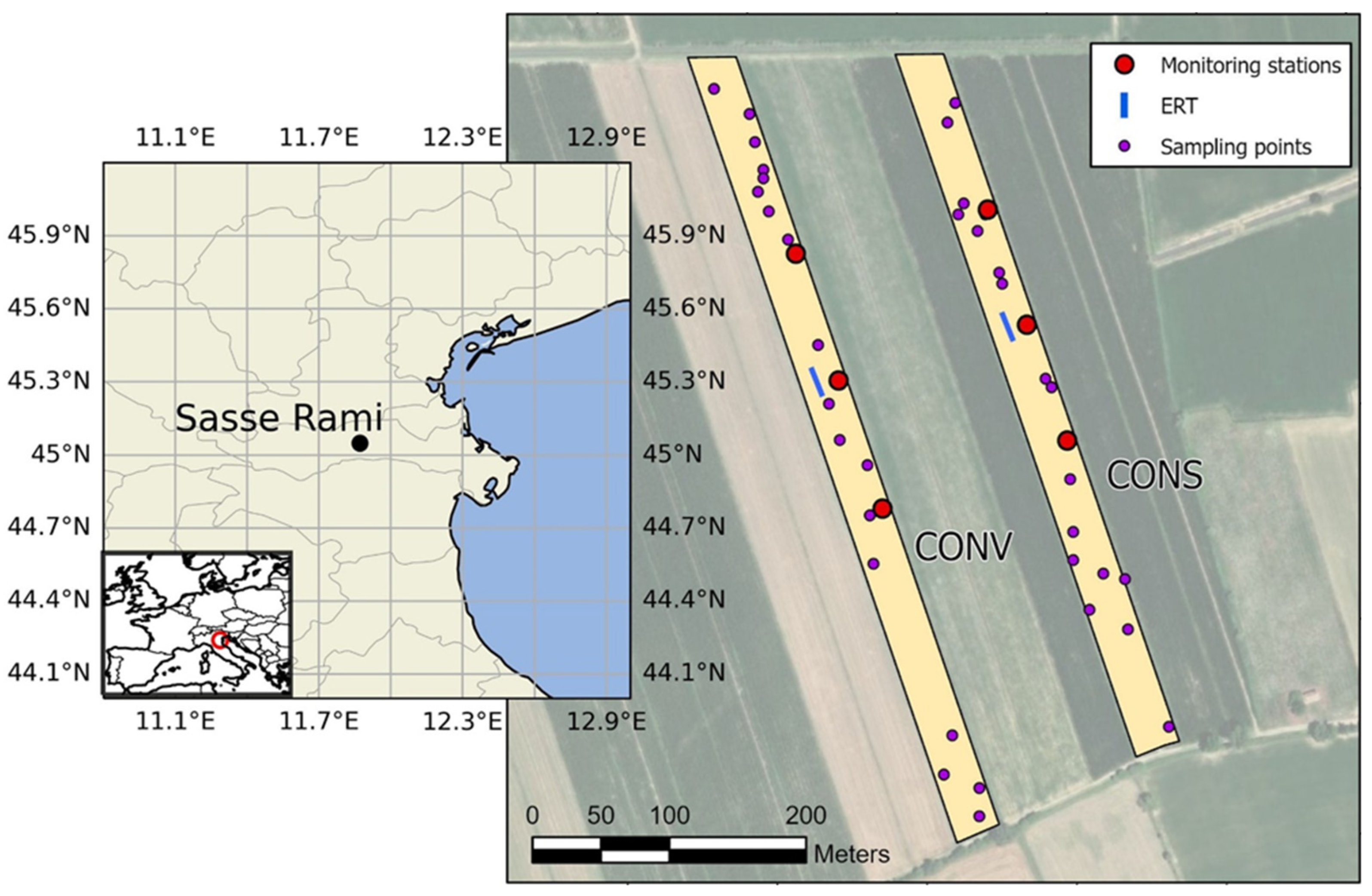
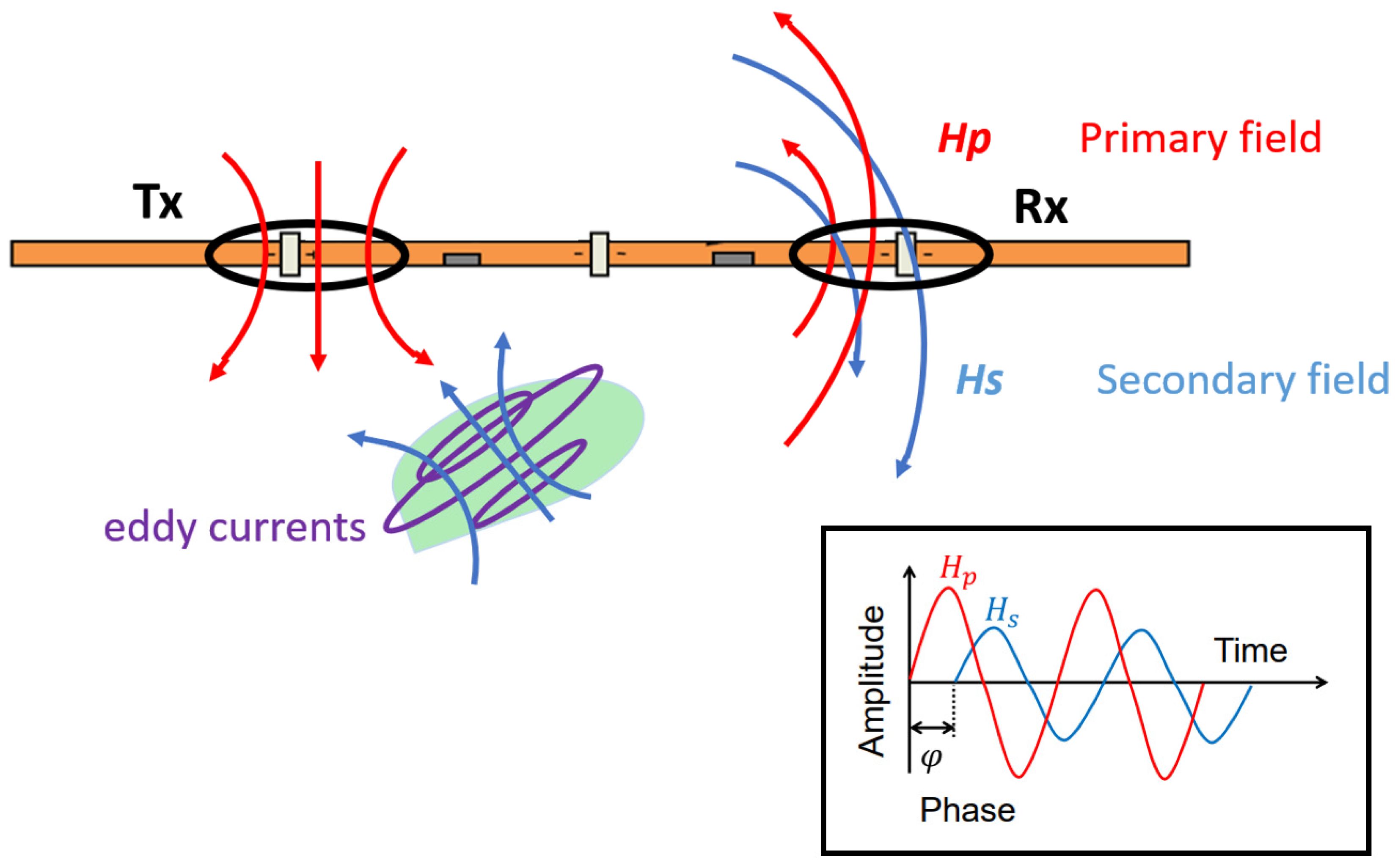


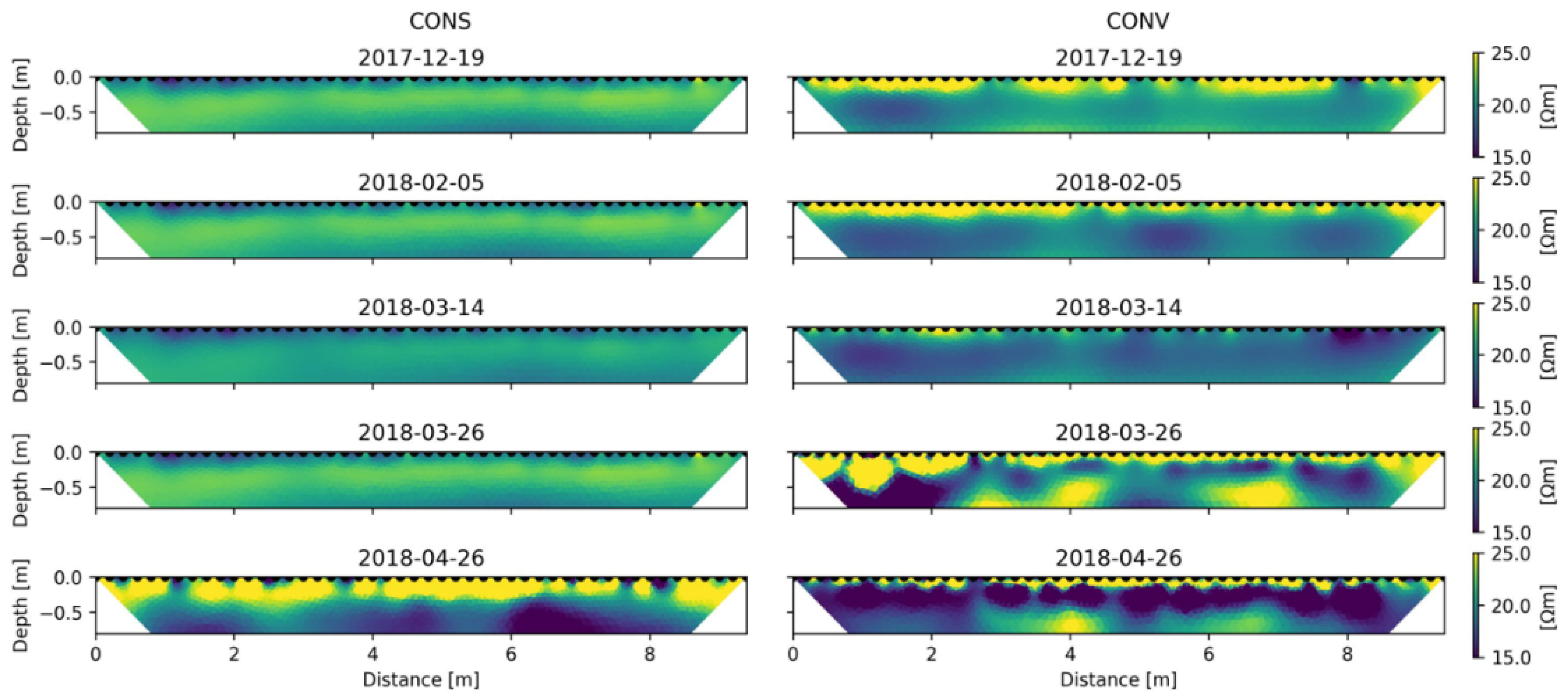
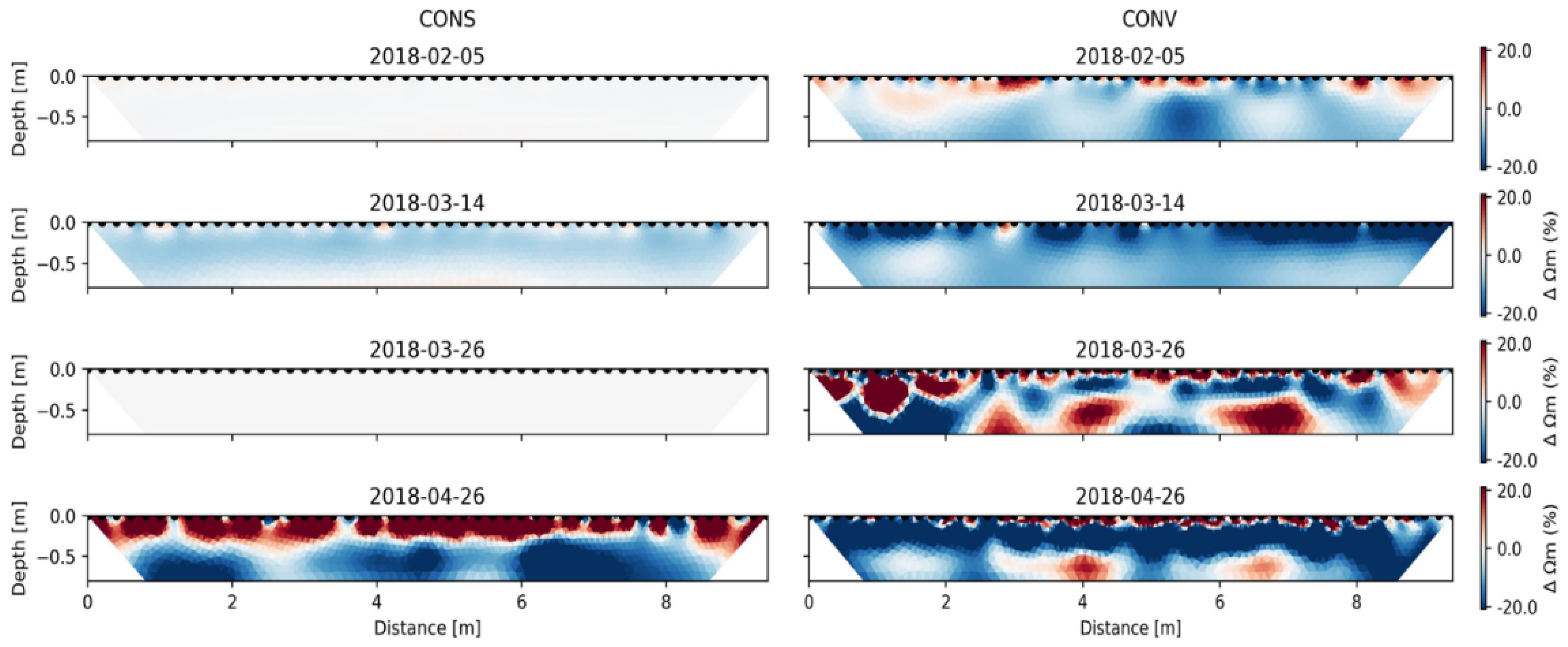
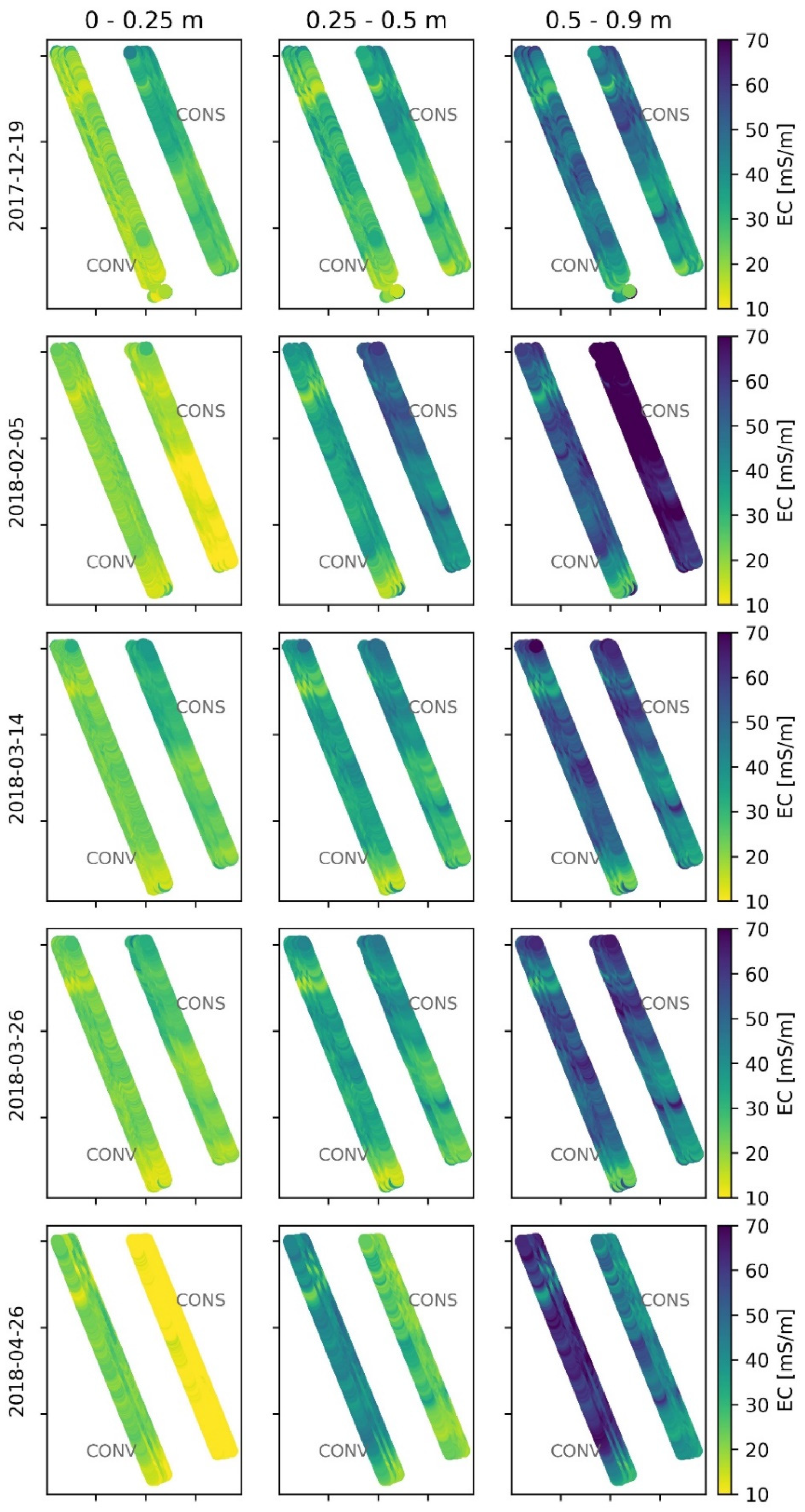
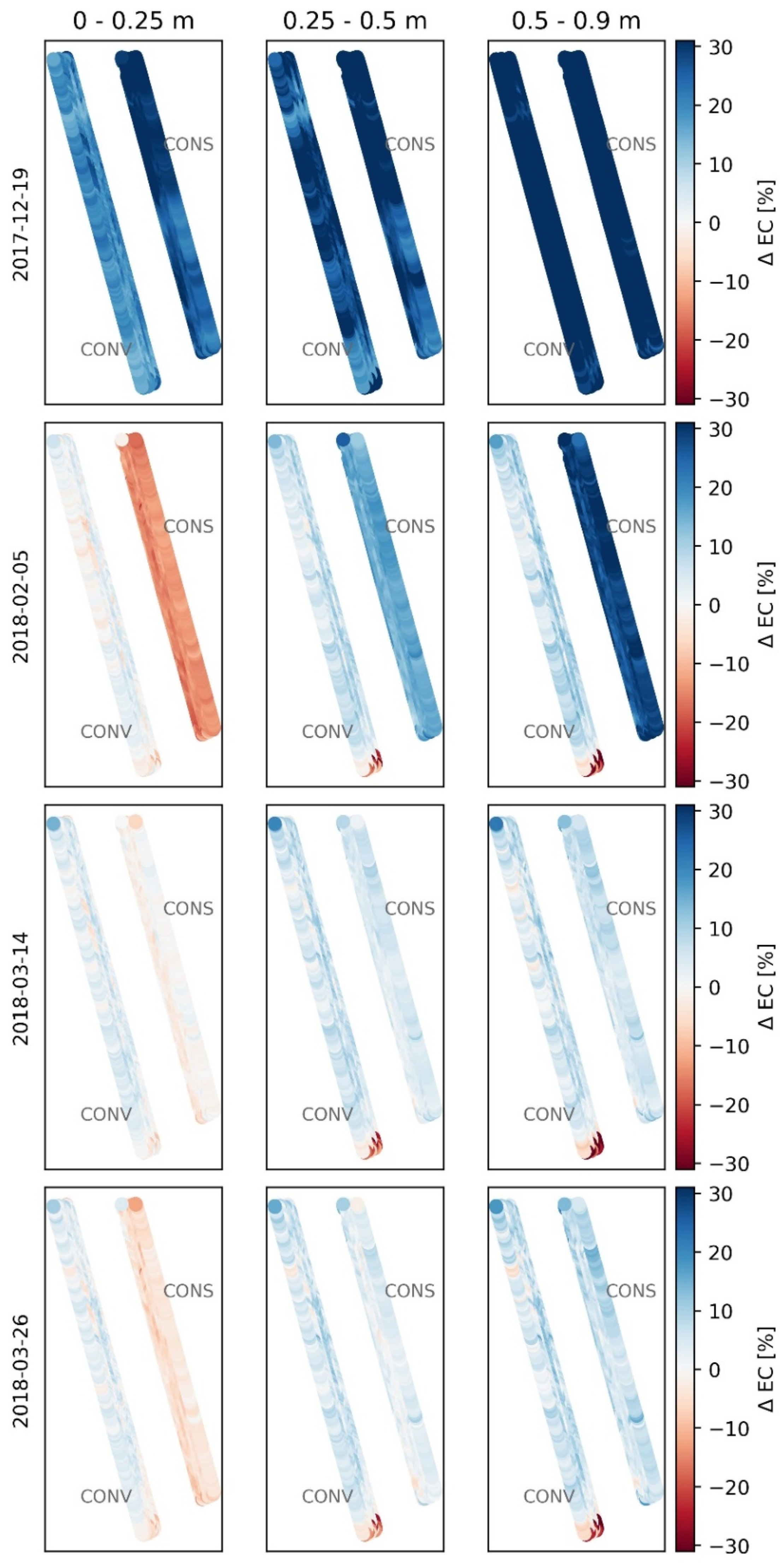
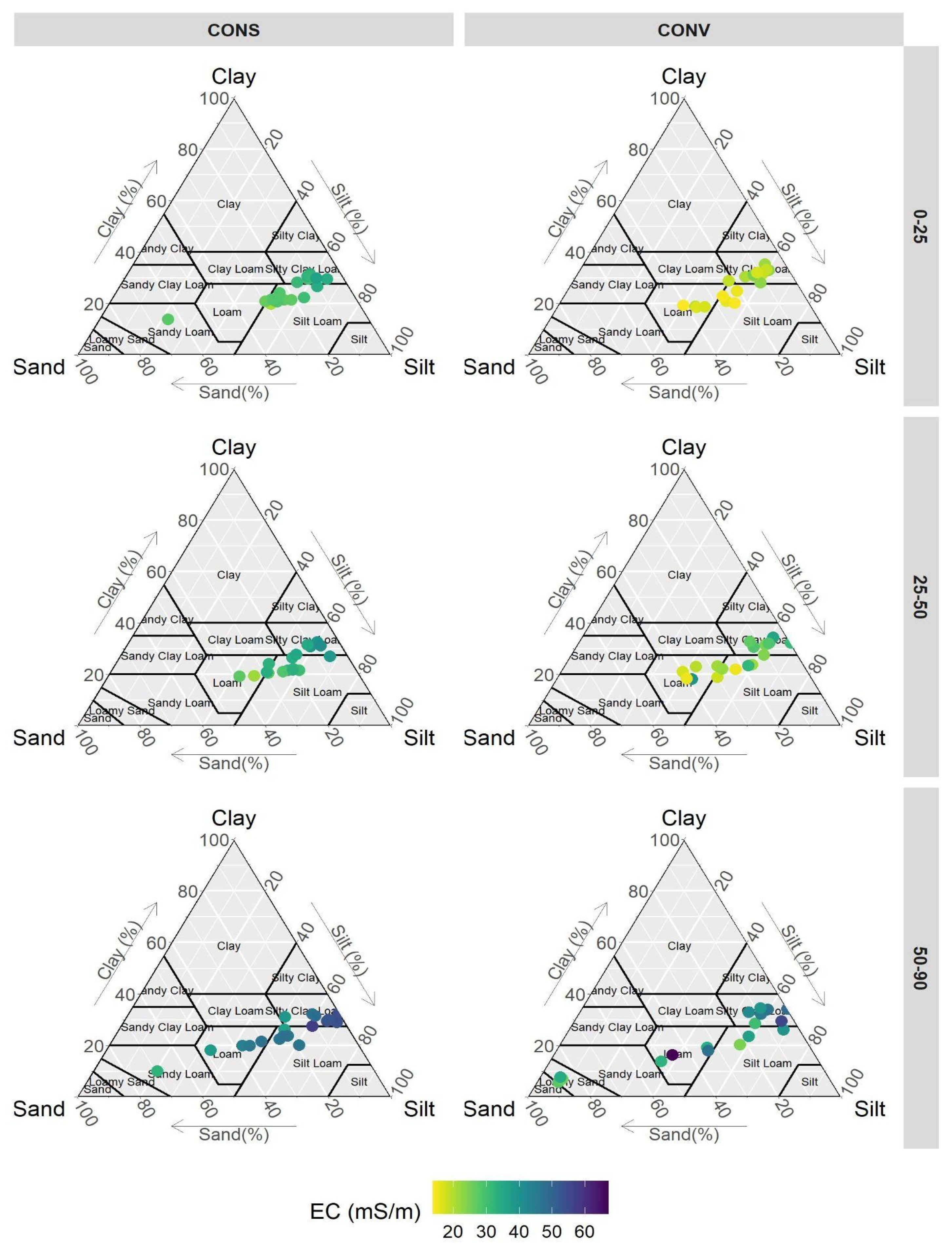
| Characteristic | Unit | Value |
|---|---|---|
| Sand | g 100 g−1 | 18.4 |
| Silt | g 100 g−1 | 57.8 |
| Clay | g 100 g−1 | 23.8 |
| pH | - | 8.6 |
| Carbonate | g 100 g−1 | 13.0 |
| Active carbonate | g 100 g−1 | 3.0 |
| Organic carbon | g 100 g−1 | 0.8 |
| Available P | mg kg−1 | 6.0 |
| Exchangeable Ca2+ | meq 100 g−1 | 15.5 |
| Exchangeable Mg2+ | meq 100 g−1 | 1.4 |
| Exchangeable K+ | meq 100 g−1 | 0.2 |
| Depth (cm) | BD | Sand | Silt | Clay |
|---|---|---|---|---|
| VWC (0–25) | 0.464 | 0.358 | −0.372 | −0.267 |
| VWC (25–50) | 0.213 | 0.310 | −0.398 | 0.078 |
| VWC (50–90) | −0.297 | −0.688 | 0.703 | 0.552 |
Publisher’s Note: MDPI stays neutral with regard to jurisdictional claims in published maps and institutional affiliations. |
© 2022 by the authors. Licensee MDPI, Basel, Switzerland. This article is an open access article distributed under the terms and conditions of the Creative Commons Attribution (CC BY) license (https://creativecommons.org/licenses/by/4.0/).
Share and Cite
Carrera, A.; Longo, M.; Piccoli, I.; Mary, B.; Cassiani, G.; Morari, F. Electro-Magnetic Geophysical Dynamics under Conservation and Conventional Farming. Remote Sens. 2022, 14, 6243. https://doi.org/10.3390/rs14246243
Carrera A, Longo M, Piccoli I, Mary B, Cassiani G, Morari F. Electro-Magnetic Geophysical Dynamics under Conservation and Conventional Farming. Remote Sensing. 2022; 14(24):6243. https://doi.org/10.3390/rs14246243
Chicago/Turabian StyleCarrera, Alberto, Matteo Longo, Ilaria Piccoli, Benjamin Mary, Giorgio Cassiani, and Francesco Morari. 2022. "Electro-Magnetic Geophysical Dynamics under Conservation and Conventional Farming" Remote Sensing 14, no. 24: 6243. https://doi.org/10.3390/rs14246243
APA StyleCarrera, A., Longo, M., Piccoli, I., Mary, B., Cassiani, G., & Morari, F. (2022). Electro-Magnetic Geophysical Dynamics under Conservation and Conventional Farming. Remote Sensing, 14(24), 6243. https://doi.org/10.3390/rs14246243








